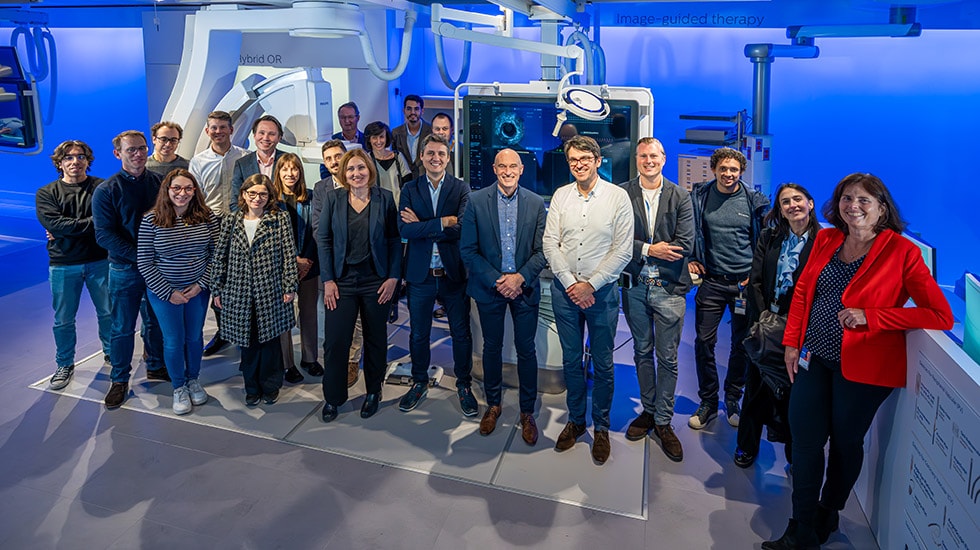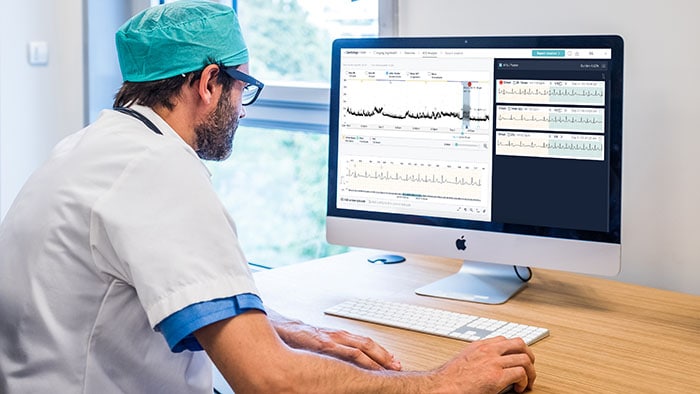COMBINE-CT public-private partnership receives EUR 6.5 million Innovative Health Initiative grant to improve the diagnosis and treatment of patients with coronary artery disease
Dec 08, 2023 | 3 minute read
The COMBINE-CT consortium [1], a Philips-coordinated public-private partnership, has received a EUR 6.5 million grant from the Innovative Health Initiative (IHI) to improve the diagnosis and treatment of patients with coronary artery disease.

Members of the consortium team at the kick-off event for COMBINE-CT
Coronary artery disease (CAD) is the build-up of fat and calcium (plaque) in the coronary arteries, gradually narrowing the arteries and obstructing blood flow to the heart. The condition affects 2.5% of the global population and claims over nine million lives annually [2]. The number of patients is expected to grow further due to the rise of obesity and diabetes worldwide.
The care pathway for the disease differs across hospitals and countries resulting in a difference in patient outcomes and mortality rates. For instance, it is estimated that 60% of the patients currently receive invasive diagnostic tests which they do not require [3].
“With the COMBINE-CT project we want to improve the care pathway for coronary artery disease, the most common heart disease.”, said Bert van Meurs, Chief Business Leader Precision Diagnosis and Image Guided Therapy at Philips. “The introduction of new technology creates more data that we can use for diagnosis and treatment. Due to interoperability challenges this information is not used to its full potential. In COMBINE-CT, we will work with top clinical centers and industry partners to open the data silos in the hospitals between different departments involved in the care of CAD patients, simplifying, and improving workflow for physicians, nurses, and technologists.”
Improving the Coronary Computed Tomography Angiography (CCTA) workflow
Current clinical guidelines adopted in the US, EU, and the UK recommend CCTA as a first evaluation for coronary artery disease [4]. By showing a detailed 3D image of the coronary arteries, CCTA enables physicians to determine whether the patient needs an invasive procedure or can follow a less invasive care pathway. Despite being recommended as the first line diagnostic test, due to challenges in interoperability across systems, devices, and geographies, CCTA is not used to its full potential.
Combining CT diagnostic data and interventional approaches for futureproof cardiology care
The COMBINE-CT consortium, coordinated by Philips, is addressing this clinical workflow challenge in the in the IHI-funded project ‘COMBINE-CT: Combining CT diagnostic data and interventional approaches for futureproof cardiology care’. The consortium includes Philips, Université Lyon 1 Claude Bernard and its affiliate entity Hospices Civils De Lyon, Instituto de Investigación Biomédica de Salamanca (IBSAL), Amsterdam UMC location AMC, University Clinic Cologne, Medical Research Infrastructure Development and Health Services Fund by the Sheba Medical Center, Cardiologie Centra Nederland, Novo Nordisk, Consorcio Centro de Investigacion Biomedica en Red M.P. and EUPATI Foundation.
With the COMBINE-CT project we want to improve the care pathway for coronary artery disease, the most common heart disease.
The project will deliver an automated, vendor-agnostic CCTA-enabled workflow for stable CAD patients. COMBINE-CT will unlock the potential of CT to improve and connect all the steps in the clinical workflow: diagnosis, patient stratification, treatment planning, intervention, and follow-up.
Clinical evidence supporting the benefits of CT across the care pathway will be generated in five multicenter clinical trials:
Sources [1] The COMBINE-CT consortium includes the following partners: Philips, Université Lyon 1 Claude Bernard and its affiliate entity Hospices Civils De Lyon, Instituto de Investigación Biomédica de Salamanca (IBSAL), Amsterdam UMC location AMC, University Clinic Cologne, Medical Research Infrastructure Development and Health Services Fund by the Sheba Medical Center, Cardiologie Centra Nederland, Novo Nordisk, Consorcio Centro de Investigacion Biomedica en Red M.P. & EUPATI Foundation
[2] Roth GA, et al. (2017) Global, Regional, and National Burden of Cardiovascular Diseases for 10 Causes, 1990 to 2015. J Am Coll Cardiol 70 (1): 1-25.
[3] Patel et al. (2014) Prevalence and predictors of nonobstructive coronary artery disease identified with coronary angiography in contemporary clinical practice; Am Heart J. 167(6):846-52.e2
[4] Narula J. et al. (2021) SCCT 2021 Expert Consensus Document on Coronary Computed Tomographic Angiography: A Report of the Society of Cardiovascular Computed Tomography. J Cardiovasc Comput Tomogr. 2021 May-Jun;15(3):192-217.
This project is supported by the Innovative Health Initiative Joint Undertaking (IHI JU) under grant agreement No. 101132862. The JU receives support from the European Union’s Horizon Europe research and innovation programme, COCIR, EFPIA, Europa Bio, MedTech Europe and Vaccines Europe
COMBINE-CT is funded by the European Union, the private members, and those contributing partners of the IHI JU. Views and opinions expressed are however those of the author(s) only and do not necessarily reflect those of the aforementioned parties. Neither of the aforementioned parties can be held responsible for them.










